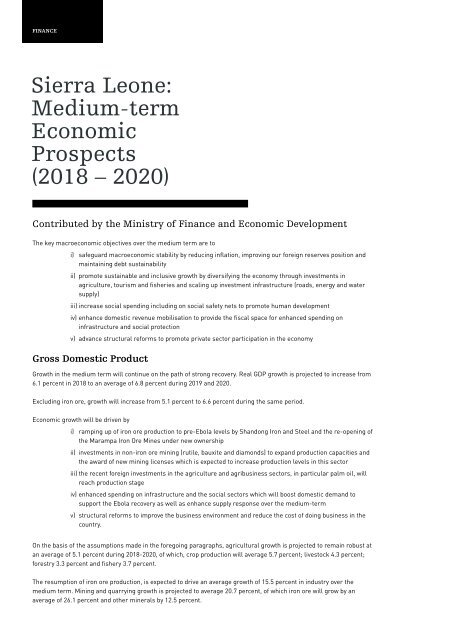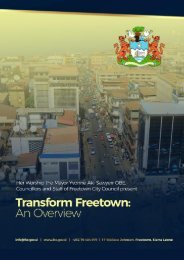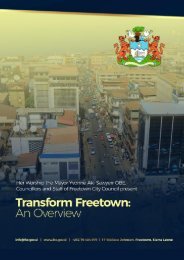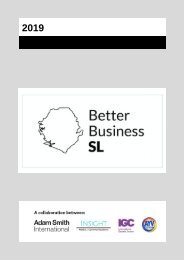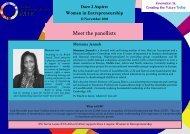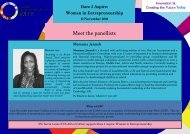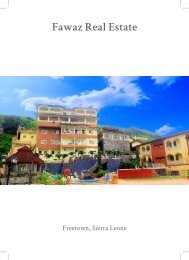Insight Magazine Issue 3 2017
Sierra Leone's most authoritative business and investment magazine. Interviews with Henry Macauley, Joule Africa, Abu Kamara, Joseph Fitzgerald Kamara and more.
Sierra Leone's most authoritative business and investment magazine.
Interviews with Henry Macauley, Joule Africa, Abu Kamara, Joseph Fitzgerald Kamara and more.
You also want an ePaper? Increase the reach of your titles
YUMPU automatically turns print PDFs into web optimized ePapers that Google loves.
FINANCE<br />
Sierra Leone:<br />
Medium-term<br />
Economic<br />
Prospects<br />
(2018 – 2020)<br />
Contributed by the Ministry of Finance and Economic Development<br />
The key macroeconomic objectives over the medium term are to<br />
i) safeguard macroeconomic stability by reducing inflation, improving our foreign reserves position and<br />
maintaining debt sustainability<br />
ii) promote sustainable and inclusive growth by diversifying the economy through investments in<br />
agriculture, tourism and fisheries and scaling up investment infrastructure (roads, energy and water<br />
supply)<br />
iii) increase social spending including on social safety nets to promote human development<br />
iv) enhance domestic revenue mobilisation to provide the fiscal space for enhanced spending on<br />
infrastructure and social protection<br />
v) advance structural reforms to promote private sector participation in the economy<br />
Gross Domestic Product<br />
Growth in the medium term will continue on the path of strong recovery. Real GDP growth is projected to increase from<br />
6.1 percent in 2018 to an average of 6.8 percent during 2019 and 2020.<br />
Excluding iron ore, growth will increase from 5.1 percent to 6.6 percent during the same period.<br />
Economic growth will be driven by<br />
i) ramping up of iron ore production to pre-Ebola levels by Shandong Iron and Steel and the re-opening of<br />
the Marampa Iron Ore Mines under new ownership<br />
ii) investments in non-iron ore mining (rutile, bauxite and diamonds) to expand production capacities and<br />
the award of new mining licenses which is expected to increase production levels in this sector<br />
iii) the recent foreign investments in the agriculture and agribusiness sectors, in particular palm oil, will<br />
reach production stage<br />
iv) enhanced spending on infrastructure and the social sectors which will boost domestic demand to<br />
support the Ebola recovery as well as enhance supply response over the medium-term<br />
v) structural reforms to improve the business environment and reduce the cost of doing business in the<br />
country.<br />
On the basis of the assumptions made in the foregoing paragraphs, agricultural growth is projected to remain robust at<br />
an average of 5.1 percent during 2018-2020, of which, crop production will average 5.7 percent; livestock 4.3 percent;<br />
forestry 3.3 percent and fishery 3.7 percent.<br />
The resumption of iron ore production, is expected to drive an average growth of 15.5 percent in industry over the<br />
medium term. Mining and quarrying growth is projected to average 20.7 percent, of which iron ore will grow by an<br />
average of 26.1 percent and other minerals by 12.5 percent.<br />
Manufacturing growth is forecast to average 6.0 percent as electricity supply improves; electricity and water is expected<br />
to grow by 5.5 percent and construction, 5.3 percent. The strong recovery of the services sector is expected to continue,<br />
averaging 5.8 percent over the review period. Of this, trade and tourism is projected to grow by 5.3 percent, transport,<br />
storage and communications, 5.3 percent; finance, insurance and real estate, 5.3 percent; Government services, 7.8<br />
percent and other services, 5.3 percent.<br />
On the demand side, domestic demand including private and Government consumption as well as capital formation<br />
(private and public investments) will continue to account for the greater proportion of our Gross Domestic Product. Net<br />
exports (exports minus imports) are negative over the projection period as imports are projected to continue to exceed<br />
exports in the medium term.<br />
Inflation<br />
Inflationary pressures are projected to be moderate over the medium term. The year on year inflation is expected to fall<br />
to 9.5 percent by end 2018 and 8.5 percent by 2020. The stabilisation of the exchange rate will contribute to dampening<br />
inflationary pressures. The proactive stance of monetary policy complemented by fiscal consolidation is also expected<br />
to contain inflation. The projected increase in agricultural production, especially food crops will also lower consumer<br />
prices.<br />
Exchange rate<br />
The exchange rate will continue to be determined by market forces. Interventions by the Bank of Sierra Leone (BSL) in<br />
the foreign exchange market will be limited to contain temporary excessive volatility. BSL will aim to become a net buyer<br />
of foreign exchange in coming years, in order to increase reserve coverage.<br />
Exports<br />
The growth in exports is projected to average 14.3 percent over the medium term, moderating from 19.8 percent in 2018<br />
to 7.2 percent by 2020 as iron ore production reaches the maximum capacity. Exports are projected to continue to be<br />
dominated by minerals. Iron ore exports are conservatively projected to increase from 12 million metric tons in 2018 to<br />
15 million in 2020, relative to 6.1 million metric tons during 2016.<br />
The second iron mining company, (formerly) Timis Mining Corporation is also expected to commence operations<br />
during the period. Diamond production will average around 540,000 carats per annum over the medium term, of which<br />
Koidu Holdings will export an average of 300,000 carats, with alluvial diamonds responsible for the remaining 240,000<br />
carats per annum. Bauxite output will average 2.1 million metric tons; rutile, 183,000 metric tons; and ilmenite, 43,000<br />
metric tons. Exports will also be boosted by the production of palm oil and other export crops such as cocoa as recent<br />
investments in this sub-sector reach production stage.<br />
Imports<br />
Imports are projected to grow in an increasing trend by 7.0 percent in 2018, 8.1 percent in 2019 and 9.0 percent in 2020 in<br />
line with the expansion in economic activities.<br />
Current Account<br />
The current account deficit will narrow down slightly - initially to 18.6 percent of GDP in 2019 from 19.1 percent of GDP in<br />
2018, before increasing to 19.0 percent of GDP in 2020 in line with the movements in the trade balance.<br />
Balance of Payments<br />
The overall Balance of Payments position is projected to turn into a surplus of US$ 22 million (0.4 percent of GDP) in<br />
2018 and remain positive throughout the medium-term - from a negative position of US$59 million (1.6 percent of GDP)<br />
in <strong>2017</strong>.<br />
Gross foreign reserves are projected to increase from US$573 million (2.9 months of imports) in 2018 to US$695 million<br />
(3.0 months) of imports in 2020.<br />
27<br />
www.insight.sl


